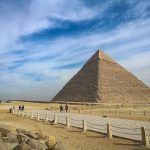Ancient Egyptian Queens
We will find more details about Ancient Egyptian Queens through this blog post from FTS press.
Women in ancient Egypt played a significant part in all aspects of life, making them a pair to men if not one of the primary reasons for the expansion of Egyptian civilization, therefore it was not shocking for an ancient civilization to respect women and take a glance at them with awe and respect for hundreds of years, making them firmly introduce in religious and mundane scenes, as well as women in Egyptian civilization have indeed been nicknamed all through the ages, such as (Lady of Egypt), (Lady of Egypt), (Lady of Egypt), as well as (Lady of Egypt) (Lady of Egypt).
The Old Kingdom’s Queens
Queens of the Old Kingdom Queen Nithotep: She is the oldest Egyptian queen found by historians. She is the wife of King Narmer, the founding member of the Pharaonic dynasty.
Queen Merit Nate
She is a member of the first family’s ruling family and did inherit the throne following her husband’s death. She is the wife of King (Jar) and is of northeastern descent, with the title implying “Queen of the North” (Beloved of Lord Nate). Her tombs were found in two places: Saqqara, Egypt’s biggest city, and Abydos, Egypt’s second-largest city.
Queen Hanutsen
Her Egyptian name translates as follows: (their lady). Queen Hanutsen was one of King Sneforu’s daughters, as well as she married her brother, King Khufu, who built a pyramid for her near his own on the south side of his pyramid.
Queen Hehotephere II: She is King Khufu’s daughter and married her throne prince’s brother (Kaweeb).
Mers Ankh III (Queen Mers)
Three Fourth Dynasty queens were named Mers Ankh, meaning “those who appreciate or love life.” The Queen’s tomb, sited east of the Great Pyramid, is considered one of the essential rock tombs in Giza. It comprises three halls and is built into the cemetery’s walls. The statues of the Queen and other members of the royal clan were imprinted.
Queen Khentkaus
She is the second Egyptian Queen to rise to the throne and govern herself. She gave birth to two monarchs (Sahure and Sahure II) (Neferir-Kara). She married one of the sun’s priests, (Userkaf), the first monarch of the 5th Dynasty, as well as bore him a son named (Sahure).
Queen Eibot I (6th Dynasty)
She was the wife of King (Titi), the founding member of the 6th Dynasty (2420-2280 BC). At Saqqara, you can see his pyramid. Queen Eibot gave birth to a son, Pepi I, who was the Dynasty’s second monarch. I built a hierarchy group for Pepi’s mother near King Titi’s father’s funeral temple.
Look here: Daily Life in Ancient Egypt
Empress Emtsy
She is the wife of the King (Bibi Iwives’) wives. He alleged her of extramarital affairs with his minister, so the king procured a judge (Wani) to investigate the case and conduct an investigation with the queen, as well as the records did not disclose the punishment that the ruler imposed on his wife, but he married another wife, the daughter of one of Girga’s greats, and they discovered a child.
Nitocris (Queen Nate Iqrit)
She is from the late 6th Dynasty (Nitocris), as well as she reigned Egypt for two years before her ascendancy did end without a trace, as well as the crown of her relatives started to crumble afterward when and; it had a pyramid in the northside near King Pepi II’s pyramid at Saqqara.
look here: Cities and Regions of Ancient Egypt
Queens of the 19th Dynasty
Queen Tuya
She is a part of the royal family and retains several titles, such as great nanny to the inherited prince. She is the wife of King Seti I and the mom of 4 kids: two daughters and two sons. After his dad’s passing, Ramses II, the youngest of her kids, ascended the throne, and Queen Tuya, rose to prominence. After her son ascended to authority, he appointed sculptures of her to be carved in the Ramesseum temple in Luxor and his new capital, east of the Delta. He built a modest sandstone monastery for her on the Ramesseum’s north side.
Queen Nefertari
She is Queen Ramses II’s wife, and one of her titles is the throne’s heir and the priestess of Hathor. She bore King Ramses II’s kids, many of whom died when they were young. In her honor, King Ramses II built a magnificent temple for Queen Nefertari, after that, to his temple in Abu Simbel. A section of Queen Nefertari’s monument with the queen’s titles can be found in the Brussels Museum. The queen died so young, and her husband, the king, mourned for her and built her a tomb in the Valley of the Queens cemetery, one of the most beautiful aspects of architecture and art.
Queen Hent Mai Ra
She is King Ramses II’s sister and one of King Seti I’s daughters by Queen Tuya. He married her and is now known as the king’s daughter, wife, and queen’s daughter. The identity of this queen, in addition to her portrait, was found carved on a statue in the Vatican Museum and on various monuments found in the Sharkia Governorate of King Ramses II Abu Kabir. The queen did die in the fortieth year of her husband’s reign. The mummy of this queen can be found at the Egyptian Museum in Cairo.
Queen Maat Neferrea
She is a Hittite queen, and he, King Ramses II, married her for political purposes after the peace agreement, the world’s first treaty. It was a battle between Ramses II and the other gods (King of the Hittites – Messis II). Ramses II married in his thirty-fourth year of rule at fifty-seven years old. The king named his queen Maat Nefer Raa which means “God’s Ra Justice’s beautify.” He had a statue of her father constructed on the war memorial on the walls of an Abu Simbel temple, and he ordered a palace built for her in a town near Fayoum. A papyrus usually contains a stock of the queen’s garments.
Look here: Ancient Egyptian Technology








